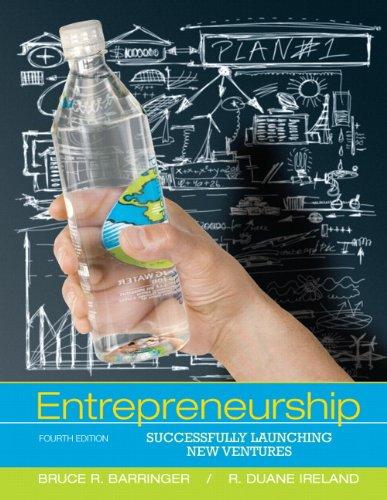d.light, the subject of Case 4.2, is a for-profit social enterprise. What, if any, special factors should
Question:
d.light, the subject of Case 4.2, is a for-profit social enterprise. What, if any, special factors should be kept in mind when writing a business plan for a for-profit social enterprise?
Case 4.2
Introduction Imagine the following. You’re in the audience of a business plan competition. The next team up to present is d.light, a for-profit social enterprise that plans to bring light to people without access to reliable electricity. Two young men introduce themselves as the founders of d.light, and say they’re going to start their presentation with a demonstration. The lights go out. In a few seconds, you see a dim light at the front of the room, and smell smoke and burning kerosene. After about 30 seconds, your eyes start to water and it becomes slightly uncomfortable to breathe. The lights switch back on and the smoke clears.
The young men apologize for the lack of light and smoke, but say the demonstration was staged to illustrate a point.
Around 1.5 billion people, or more than one fifth of the world’s population, have no access to electricity, and about a billion more have an unreliable or intermittent supply. A large share of these people use kerosene to light their homes at night. Kerosene fumes are extremely unhealthy, even fatal. In fact, the United Nations estimates that kerosene fumes kill 1.5 million people per year, and cause countless health complications for others.
Sam Goldman and the Origins of d.light The scene described here actually took place—several times. It’s the way Sam Goldman and Ned Tozen, the cofounders of d.light, introduced the company at business plan competitions and when they pitched investors. d.light is an international consumer products company serving “base of the pyramid” consumers who don’t have access to reliable electricity. Although d.light technically started in a class at Stanford University, its beginning can be traced to Sam Goldman’s youth and early adulthood. Growing up, Goldman’s parents worked for the United States Agency for International Development (USAID), a government agency that provides economic and humanitarian assistance in countries across the globe. Goldman lived in Pakistan, Peru, India, Canada, and several other countries.
As a young adult, while working for the Peace Corps, he lived for four years in a West African village that had no electricity. A neighbor boy was badly burned in a kerosene fire, an event that deeply impacted Goldman. At one point during his time in the village, Goldman was given a battery-powered LED headlamp, and was struck by the dramatic difference that simply having light at night can make in a person’s life. He could now cook, read, and do things at night that were unimaginable without the benefits reliable lighting provides.
Impacted by this experience, Goldman sought out a graduate program that would provide him the opportunity to start thinking about creating a business to take light to people without access to reliable electricity. He landed at Stanford, which was starting a program in social enterprise. A pivotal class was Jim Patelli’s 2006–2007 Entrepreneurial Design course. The class was divided into teams, and each team was challenged to address a significant issue in the developing world. Goldman was teamed up with Ned Tozen, a business classmate, and two engineering students, Erica Estrade and Xian Wu. The team tackled the problem of light for people without access to reliable electricity, and developed a rough prototype of a portable LED light that could be recharged via solar power. That spring, the team traveled to Burma for the purpose of going into villages that didn’t have access to electricity to introduce their device. Villagers told them they spent up to 40 percent of their income on kerosene. When shown how their crude prototype could provide light at night and be recharged during the day simply by deploying small solar panels on their homes, the villagers were so taken that one women actually wept.
According to one account of the team’s trip, in one village the local police confiscated the prototypes. They, too, needed light at night.
Step by Step Answer:

Entrepreneurship Successfully Launching New Ventures
ISBN: 9780132555524
4th Edition
Authors: Bruce R. Barringer, R. Duane Ireland





